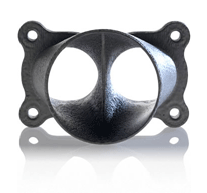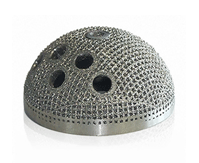The UK’s £10 million Mercury Centre to focus on near net shape powder-based manufacturing
August 1, 2011
A £10 million development centre which aims to accelerate the deployment of a range of innovative near net shape powder-based manufacturing processes has been created in the UK by the University of Sheffield’s Department of Materials Science and Engineering, following dialogue with regional advanced manufacturing companies to understand their future needs.

Formula 1 exhaust port manufactured
by electron beam additive layer
techniques, image courtesy of
Arcam AB.
The Mercury Centre is part financed by the Europe Union, attracting over £5 million of investment from the European Regional Development Fund, as part of the support for the region’s economic development through the Yorkshire and Humber ERDF Programme 2007-13. This European investment is enabling UK industry to secure a globally leading position by accessing faster time-to-market technologies across a range of sectors.
The Mercury Centre has acquired a series of equipment which will deliver cutting edge capabilities in a range of advanced manufacturing technologies such as 3D printing, functional coatings and surface treatment. These include;
- Additive layer manufacture of high value alloys based on an Arcam S12
- Functional 2.5D printing of electronics and biomaterials with Aerosol Jet Deposition
- Novel material processing via Spark Plasma Sintering for rapid development of new ceramics
- Metal Injection Moulding and sintering
- Electron beam processing for joining, surface treatment and building parts
These are supported by a range of state-of-the-art advanced materials characterisation techniques, and product/process design & simulation capabilities.
Near net shape manufacturing using these techniques allows components with complex geometries to be created directly from computer models offering benefits over traditional manufacturing processes including; rapid development times, fewer process steps, lower environmental impact and reduced cost, at the same time as providing improved product quality and increased design freedom. Recent developments in the technologies now allow application across a wider range of industrial sectors and there is already significant interest from aerospace, motorsport, biomedical and electronics companies. These are now supported by the increasing availability of production-scale equipment and a range of bulk powder feedstocks.

Actebular cup for hip joint
replacement manufactured by
additive layer techniques. Image
courtesy Mercury Centre, UK.
Like all new processing technologies, however, industrial deployment generally requires substantial development activity to identify the composition and processing conditions required for a new product or new application, and this is where The Mercury Centre comes in.
Dr Iain Todd, the Centre Director explains, “We are helping companies to adopt these technologies by offering them access to our research facilities and the opportunity to explore the business benefits. We can provide a phased approach, beginning with an initial investigation of business needs and exploratory tests, through to long term-product or process optimisation. We can also offer a “no risk” proof of concept engagement to obtain preliminary data which can then be used in the development of subsequent funding applications”.
The University states that there are a range of options for working with The Mercury Centre, from short term contracted consultancy, through to knowledge transfer partnerships (KTPs) and PhD studentships, or even large scale multi-partner projects. Contact the Centre Manager, Dr. Martin I Highett, on +44 (0)114 2225981 for further information.
www.shef.ac.uk/faculty/engineering/
News | Articles | Market reviews | Search directory | Subscribe to e-newsletter















